
Neck Sharpies: Outside of This

If you were around for the first Rich Rod year, when Michigan's offensive talent wasn't on the same level as most of their competition's, you may remember there would often be some cute trick in the Wolverines gameplan. This gambit would work for a quarter before the defensive coaches got a moment to explain what's happening. Their answer would stress another part of the late-aughts Michigan offense that couldn't take it, and that would be that. Still, the yards and scores all counted. Several of the results also made Paul Nelson's legendary 2009 hype video, which has since become this site's anthem.
Now that you've watched that to remember how far we've come, turn back to 2:54 for the Purdue/Penn State sequences. Michigan actually led Penn State 10-0 in the 1st quarter in 2008. They lost 17-46.
Fast forward 15 years, and Michigan's the heavy favorite adjusting to some cute gambit in the 1st quarter before shutting it down with a simple reaction. Minnesota's trick, which led to a 54-yard field goal attempt, was actually pretty similar to Rich Rod's against 2008 Penn State, another team built on the strength of its defensive tackles.
The base play Minnesota was using was zone stretch. Or outside zone. We never decided on what to call it, but it's the second time we've talked about it this year because Michigan spent the UNLV game trying to rep it. When that happened I posited that Stretch is tough to add as a second pitch to your running game because it takes a lot to get right. Minnesota uses it as its #1, and found ways to repeatedly crack Michigan's front by using backfield motion to stretch the of horizontal space Michigan's linemen had to cover on their own.
The short explanation is Minnesota attacked the way Michigan prefers to play the run without committing much material to it. Minter's defense likes to set its edge and leave their defensive tackles to keep things under control in between them until the ball is handed off. This allows the linebackers to pursue passing targets and the edges to remain in position to rush the passer, stressing the DTs to gain a measure of immunity to play-action. Minnesota was using motion from their tight ends and receivers before and after the snap to spread out those edges, which overstressed the tackles, and created wide lanes before the linebackers could get back to help. Hit the jump and I'll show you how and why, and how Michigan responded.
[After THE JUMP: Stretch in Space]
ESTABLISHING THE TENDENCY
Just as we saw with Rutgers (the throws underneath Cover 3) and Nebraska (the slants), the first time Minnesota declared what their Thing was gong to be was not with the thing itself but the counter to it. The Gophers motioned a receiver across the formation, then motioned a different guy the opposite direction and ran play action. Michigan was all over it.
After you've watched this play, rewind and watch what happens with the linebacker level pre- and post-snap.
1. The F-Tight End's motion brings Makari Paige (#7), the box safety, inside the formation like a linebacker while the other two ILBs have to widen with his motion.
As he continues outside post-snap, Jaylen Harrell and Mike Sainristil widen as well.
This is messing with a fundamental rule of Michigan's defense: do not get edged. Run or pass, if the offense is going to race material outside Michigan wants to have a defender responsible for that guy who's staying on his outside shoulder at all times. As he passes each gap, the defender in that gap has to shift one gap over to make sure whoever's at the end of the line is free to keep the play inside his shoulder.
Of course as soon as the snap comes WR#4 on the bottom starts motioning across the formation the other way. The DE on the top, Braiden McGregor, widens a bit as he gets read on what looks like a zone read option. Paige spots the WR and has to reverse course, returning to his role as a box safety.
This attempt then resolves into play-action. As soon as he realizes this Barrett, the WLB, stops moving down towards his run gap and picks up the inline tight end that Minnesota was really trying to hit here:
With everyone covered and McGregor coming up to pressure, Kaliamanis turfs it. It's a successful defensive play. But Minnesota was able to confirm how Michigan was going to react to threats leaking out of their edges. And one pick six later they would put it to use.
HOW MICHIGAN WANTS TO DEFEND STRETCH
We've spoken several times this year in UFRs and whatnot about how Michigan's leaning on their DL to get away with extra coverage. This worked very well against the Bowling Greens and whatnot who major in Inside Zone concepts and couldn't get any movement on the Michigan defensive linemen.
The way they like to do this is to set a hard edge with a bigger force player, preferably the playside DE, then have all of their linemen keep theirs on the line of scrimmage, shoving the blockers—and with them the ballcarrier—towards this wall, until the RB's "gap" is just a pair of friendly shoulders squeezed together. Once he's hemmed in, the linemen and whatever linebackers want to join the fight can shed their blocks and pick out limbs from the ballcarrier to bring back to their dens. Watch #17 Braiden McGregor on the bottom set the edge, the DTs reset the line of scrimmage, and the back get trapped in the squeeze until the WLB and the WDE arrive from the backside.
The first time Minnesota ran stretch they didn't have any frippery attached, so we got to see how the plan was supposed to work, and why it didn't.
You can see Harrell setting a hard edge on the bottom of the play. He has the OT in the backfield and is able to come off to make a tackle attempt inside if the ball comes to him. He does get moved out a bit, which isn't ideal, but the play has to go inside of him.
Jenkins however does not have his blocker on the line of scrimmage. In order to stay in his gap he had to use most of his effort to get across from this blocker, with every foot he gives up vertically to do so a foot the running back can use. Same with the linebackers, except with them it's more about when they activate, how the contact point goes when the slam into their blocker's shoulder, how they get off that block, and how they do on the tackle. On this one Barrett did okay on the impact and disconnect parts, initiates his tackle at about 4 yards, and gets run over for another 2 yards as Jenkins comes off his block to finish.
This isn't tactical; this is the defense getting beat the normal way. Jenkins(-1) and Graham(-1) got moved to create some running space, Barrett got to his spot and made the tackle. The space between Jenkins and Graham in the image above is the space the running game has to operate in.
The above was optimal conditions: a defensive line that set up with a lot of space between the DTs, a linebacker that wasn't shooting his gap until he was certain the QB handed the ball off, no safeties coming down to help. The offense isn't blocking the backside end, so there's a blocker for every defensive hat. The defense is at a disadvantage against a base run here, chosen to give them an advantage against any throws.
We've seen Michigan's DTs win battles like these without needing Barrett's help. The thing about Stretch is it creates more of that space, albeit at the cost of movement downfield.
MOTION GAMES
So we know Michigan wants to play defense by setting a hard edge and winning with fewer players inside of that edge. We also established that Minnesota was able to use motion to stretch both edges of Michigan's defense. See where I'm going with this? The motion created more space between the edges, and Michigan's obsession with keeping second-level defenders strong against the pass took material out of the middle, meaning the guys responsible for the run were ending up with more horizontal space to defend with less help behind them.
Here's Minnesota's second Stretch play:
Look at all the backfield motion they're dealing with at the same time as the stretch blocking. Michigan's response seems to be having the DL slant to (our) right while the LBs replace the new backside gaps. But there's a problem with this plan:
Jenkins can't get across LG #75, and Barrett is hopping to the gap that Jenkins is actually in.
What I want you to notice is how much space this motion has added to the space Minnesota is attacking (everything between McGregor and Harrell). That's a much larger surface than the Bowling Green example. It's a much larger surface than the first stretch run that got six yards. This play has extra success because Jenkins lost his battle—he's not on the correct side of #75. Barrett has a chance to make him right by swapping gaps, but doesn't. In fact he's reacting to the TE still.
And since Colson isn't activating either the guy doubling Graham on the front side gets to choose if he wants to thunk him to make that gap wider or go hunting for the linebacker. He chooses Colson, and Graham is starting to fight back.
He gets a little bit held…
…and Jenkins can't squeeze the gap shut between them before the RB is through.
The live play really emphasizes how overcommitted Michigan is to defending the edge with all of the motion towards it, up to and including Harrell checking the quarterback. They've left all of that interior space to the tackles, with whatever assistance their linebackers might provide. Here they provide little assistance, and the DTs aren't superhuman for once.
An illegal motion that wasn't really relevant to the play got this one called back and Michigan covered a pass on 3rd down, but Minnesota went right back to the well on their next drive. Just like the play-action on the first play, a receiver motions across the formation pre-snap, and a tight end goes backside to feint a split zone block.
…and once again this looks like a VERY big surface for the DTs and their LB friends to cover between the edges.
This time the DTs are the backups and they're not given as tough of a job as the starters. Grant is supposed to occupy the frontside A gap and Benny is coming upfield after taking a shoulder from the guard while staying in the backside B gap. But as the tight end crosses them their gaps are changing. The DTs now need to get across the blockers in front of them so the LBs can take the gaps behind them.
Meanwhile the play is getting further away from him. The buck stops at Derrick Moore, but he's getting wide as the receiver pops out, since he can't let that guy take away the edge. The force player on the backside, Josiah Stewart, is also flat-footed. Is anything—run, pass, or bootleggy quarterback—getting outside those edges? No. But there's quite a lot of surface area for the defenders inside those edges to handle versus the same number of defensive players. Both DTs get to their gaps, though Benny let LG #65 release playside of himself (it's called getting scooped). That's okay as long as the backside guy doesn't do so as well, because by going vertical the OL is sacrificing his horizontal advantage.
Or it would be okay if the backside linebacker was able to make him right. Unfortunately Colson has picked up the TE coming across the formation and cheated so wide that he's almost off screen on our replay. When Benny gets across the LT there's nobody in the gap behind him until Stewart. The RB sees his lane is cut off at Grant, but works his eyes backside and sees a lane forming. He presses the gap to get Hausmann to commit to getting blocked by the center,
The hops behind Benny's back.
Luckily #65 got too far downfield and Colson is able to come upfield of him to join Quinten Johnson in shutting it down.
Their game established, Minnesota goes on a drive. Next play is the same play, with the announcers picking one guard to thank, either because they don't think you can figure out how multiple blocks and multiple guys can all matter to a play, or because it's hard to see what happened in one go and they're just making it up. I think you can figure it out now:
Pre-snap motion across from the wide receiver purple-shifts the front.
And post-snap motion across from the tight end double purple-shifts the front.
That stretches Colson's responsibilities too far, and he takes the coverage one. This time at least Michigan isn't leaving two guys back there, however. Stewart reacts to the crossing TE by crashing inside, which should in theory cut off the backside.
However the DTs haven't held up enough to pay it off. With Benny getting scooped by LG #65 and LT #69, and Grant getting super washed by RG #75 who's in his chest, and the linebackers shitting out backside, the center can lead through the gap.
Grant does deserve some blame because you want him to stop moving, but he was understandably racing to cross RG#75 to control his gap, and he's large, and reversing course when you're being ridden is hard. If you're requiring Grant and Benny to get across multiple blockers, then back across those blockers again, to cover all the space between where Moore set an edge on RT#77 and where Hausmann ended up, you're asking too much of your DTs.
So of course next snap Minnesota ran it again. I'm not even labeling this one for you. Just watch the WR cross the formation to shift everyone's Grant and Hausmann behind him trying to get right while the TE steps out like he's going to crack Harrell, then turns inside and lead blocks as Harrell flies out of the play.
They probably could have kept on going because the next play was play-action off of this stuff and Michigan kills it because they're *still* overreacting to the pass, tackling this for a loss (that the refs marked out at the 41 because they were handing Minnesota extra yards like candy).
Notice something else though?
THE REACTION
Well after Minnesota converted on 3rd & short with a play-action pass that was insanely lucky not to be a sack or a bat-down, they went back to the well, and once again the Michigan DTs would have to do something outside human capacity to stop it.
This was a reaction, although not one expected to go THIS well. Because Graham was so successful it actually hid how successful Michigan's reaction was going to be. For that we have to deconstruct a bit. Watch #23 Michael Barrett, the linebacker on the top, reacting to the WR crossing the formation. The gaps are still shifting when he goes by, but by bringing him down what was a weak node is now a powerful one. As for the TE crosser, since he gets stopped by Graham as well there is no widening on the backside. Michigan isn't actually expecting Graham to get upfield so fast that he tackles the RB on the handoff. They're expecting him to get upfield fast enough to intercept the crosser so that Jaylen Harrell can pinch the line down and the RB is forced to run into a hard node: Barrett or Jenkins. The surface area to defend has been both halved and compressed.
THE OTHER REACTION
But for the times when Superhuman Mason Graham wasn't going to be available, I want to go back to the play-action I clipped one play ago. Watch the defensive line before the snap.
Specifically that the DL lined up in an under, waited for the offense to make their line calls, then shifted to an Over.
While they got play-action here, this would continue. Minnesota had a counter planned for that: they started setting up with multiple TEs or a TE and a WR on one side then if they got a shift they didn't like they'd flip them to the other side before starting the motions. Michigan varied their DL attacks enough that trying to stretch multiple gaps over was more likely than not to blow up in their faces. The next time they tried it the linemen slanted past their blockers, and the blockers had to try a new tactic.
Minnesota would get a few more good gains until putting this away in the second half, but with spotty reception, because all Michigan needed to do was shift correctly one time to put the Gophers behind the chains. There was one more I wanted to highlight however, because it seems they never did give up on making the DL fight across their blocks so they could save the linebackers for spill duty.
Or I should say "linebacker" because by making a five-man front they were only giving themselves one guy to clean up. Watch Michael Barrett, the lone LB. Minnesota is attacking the wide gap between the NT (Graham) and DE (McGregor) on the left, but the way they're doing that is to have McGregor get all the way from his Wide-7 alignment across the LT. It's a tough ask that he accomplishes, and the whole time Barrett is hanging out behind all of this, and ends up outside the TE in the end.
This is dangerous stuff they're playing with, but Michigan's certain their defensive linemen are good enough to handle this stuff on their own with just a few adjustments. We'll see if another line can cause as much damage as Minnesota's did. So far in UFR they're the first team to get a significant number of negatives on them.
As for whether Michigan is capable of actually defending these conventionally, yes. Here's what it looks like when their linebackers actually attack it instead of focusing on every motion and tight end who might go into coverage. I think the takeaway here isn't that Michigan struggles with zone stretch, although I think Benny and Grant could use some reps at it to prevent cutback lanes. It's that Michigan used the Minnesota game to practice the way they plan to play Ohio State. Yes they gave up some yards on the ground. But Kaliakmanis also had just 52 yards passing, minus 62 yards in pick-sixes.
October 10th, 2023 at 9:28 AM ^
I remember that hype video vividly. Those were some dark times for sure.
October 10th, 2023 at 12:12 PM ^
This video literally brought a tear to my eye. Thank you....
October 10th, 2023 at 1:07 PM ^
Thank you for sharing. Needed this today :)
October 10th, 2023 at 5:34 PM ^
Can't stop watching....thanks for posting this!
October 10th, 2023 at 10:25 AM ^
Thanks a lot, Seth. That hype video was brutal to watch; now I need to go find a dark room, get in the fetal position, put "Hakuna Matata" on an endless loop, and remain there until the dread passes.
October 10th, 2023 at 11:55 AM ^
What is the song in that hype video?
October 10th, 2023 at 12:18 PM ^
Rilo Kiley is the artist and 'Better son or daughter' is the song title:
October 10th, 2023 at 12:29 PM ^
Thanks for the link.
Wow, great build, crazy song.
October 10th, 2023 at 12:55 PM ^
That's not a 'hype' video - it's a morbid reenactment of a funeral.
I didn't know what it was, so I flipped the 'on' button expecting some good times from a season with few to share.
Fuck you, Seth. That was cold, and I bit in hard...
October 10th, 2023 at 1:54 PM ^
Coming into the 2009 season, it was a very appropriate hype video. It’s one of those “you had to be there” type of videos.
October 10th, 2023 at 3:36 PM ^
We were Linus, waiting for the Great Pumpkin - RichRod - to deliver us football success, if only we were sincere enough.
Those were dark days.
October 10th, 2023 at 9:32 AM ^
That was a lot to take in. I find the basic jist of it to be that Minnesota knew Michigan is obsessed with setting edges and squeezing everything back inside. So they went all "fine, we'll lose that battle and win the war" by using pre-snap and post-snap motion to move the edges out extra wide and doubling the DTs so inside gaps would open up. But the reason this worked at all is because Michigan is playing every opponent like they're Ohio State, seeing just how little help the DTs can get away with in the run game because they're really only worried about an NFL passing attack.
What am I missing?
October 10th, 2023 at 10:43 AM ^
That was my basic takeaway too. Minnesota spread the edges as far apart as possible with motion, hammered the DTs with doubles, and then took advantage of Michigan's LBs having their run-pass sliders pushed hard towards pass. In other words, Michigan decided to do some shakedown runs with its Ohio State outside zone defense. I suspect Minter will be back in the garage for the next few weeks to reattach and reinforce the parts that shook loose.
October 10th, 2023 at 11:26 AM ^
It seems like OSU was anticipating we'd try to slow them with a similar defensive game plan as last year, and combined with their step back in quarterback play, it feels like they are trying to lean more on the run game and become more balanced. 3rd and 2 is no longer a primarily passing down for them. They aren't great at running it yet, but they may not be so one dimensional this year. Interested to see how it plays out.
October 10th, 2023 at 1:06 PM ^
Yeah the meta game between Harbaugh and Day the last few years has been fascinating.
Harbaugh implemented an NFL defense that neuters pass happy attacks like the Chiefs with Mahomes. While this scheme is tough on opposing QB's, it does let you drive the field if you're disciplined and take the small chunks over and over that the defense gives you in return for not allowing explosives over the top.
Ryan Day still hasn't figured out to how to counter this, because it requires a balanced offense (which he wants, but doesn't seem to be able to make work). Their OL recruiting for years has favored pass protecting tackles, not run mashing guards for obvious reasons, which is making the run game nearly impossible to fix. And now, he doesn't have a Heisman caliber QB to bail him out, either.
So, what Day does from here will be interesting, because he can either keep trying to make fetch (a run game) happen, or he can simply lean into being a Big XII team and throw the ball to Marvin Harrison Jr. every single play and just see what happens.
October 10th, 2023 at 2:38 PM ^
+1 for Mean Girls reference!
October 10th, 2023 at 3:32 PM ^
Ryan Day still hasn't figured out to how to counter this, because it requires a balanced offense (which he wants, but doesn't seem to be able to make work).
I don't think he wants a balanced offense. He just says so to appease the fanbase. When push comes to shove, he's passing the ball.
October 11th, 2023 at 10:36 AM ^
I worry that throwing to Marvin Harrison Jr. every single play will work.
October 10th, 2023 at 3:46 PM ^
I don't think taking a step back in QB play was part of the plan.
I don't necessarily agree with some folks around here that portray Day as single-minded. What happened there is he's a pass-first coach, sure, and so of course built a death machine that passes the ball to oblivion. Why wouldn't he play to his own strengths? But in sports, opponents attack your weaknesses, and when it came time to run the ball he had neither the players nor personal experience to do it effectively. It's not that passing defines him, per se; it's that you can't spend years building something and then suddenly turn it into something else, just like how Michigan isn't built to run stretch.
I'm sure OSU would like to become more balanced, but they'd have to rebuild their entire program from the ground up. In the meantime, Michigan will continue to overcommit to the pass and dare OSU to run the ball.
October 11th, 2023 at 3:13 PM ^
I agree with this. I can't find the article but there were some guys attached to the NFL who truly believe that pass heavy offenses makes your defense soft. It seems as though Ryan Day is trying to make his team tough by running more but that doesn't play into the talents of the guys he recruited.
October 10th, 2023 at 11:40 AM ^
There's the granular analysis of what they're doing, and the larger picture of why they're doing it.
MInnesota used a tactic that worked pretty well, for a bit.
Michigan gave up some space laterally to cover various passing dangers.
The result: Minnesota gained some yards and kicked one field goal.
So Michigan was ok with absorbing this a bit because it provided no threat whatsoever to the team as a whole.
This kind of gambit is part of gameplanning, and it can certainly be taken to unhealthy extremes--take Penn State's suicidal two-high D against our running game last year--but it certainly seemed to work out fine for us here against an overmatched opponent.
October 10th, 2023 at 9:32 AM ^
The more I read these analyses, the more I appreciate just how sophisticated football can be, and the more I respect the players who can make these reads and adjustments. That, and the more I appreciate what a brilliant move it was for Harbaugh to lift defensive concepts from his brother’s defense.
October 10th, 2023 at 12:33 PM ^
Intellect in is a vastly underrated player skill set by your average football fan.
October 10th, 2023 at 9:50 AM ^
"... first Rich Rod year, when Michigan's offensive talent wasn't on the same level as most of their competition's ..."
That's for sure. IIRC Michigan had one returning starter on offense. That team wasn't destined for great things. (Yes, I know RichRod made things worse.)
October 10th, 2023 at 9:59 AM ^
Steven Threat and Nick Sheridan - the Heisman duo.
October 10th, 2023 at 1:10 PM ^
Good ole Threet-Sheridammit
October 10th, 2023 at 10:01 AM ^
Hey Seth- using the app for the first time. Any way to refresh or go back in the app? Otherwise, it resolved all the issues I was having.
October 10th, 2023 at 10:17 AM ^
I think if you go all the way to the top and then thumb down (like you want to scroll higher) it will reload.
October 10th, 2023 at 11:43 PM ^
Swipe inward at the upper left of the screen and you'll go back. Took me a long time to figure that out...
October 10th, 2023 at 10:32 AM ^
What a great write-up--thank you, Seth! As I was watching live, I was seeing the outside zone they were running, but without this breakdown, I wasn't really able to appreciate why it was working so well against our normally stout-against-the-run front 7. Your explanations make perfect sense with what Michigan and Minnesota were trying to accomplish, respectively. This site, as always, has such amazing football analysis. Bravo!
October 10th, 2023 at 10:46 AM ^
Which remaining opponents run OZ a lot? I need to know which games I should pour an extra drink.
October 10th, 2023 at 12:31 PM ^
Penn State's rushing attack is the only one I'm really scared of besides OSU (they have talent at RB and my BPONE is still alive and well)... and I don't think their OL is as good as Minnesotas'.
Indiana is just another sacrifice to the CFB Gods, Maryland beats themselves and MSU is a couch fire inside a dumpster, inside a bigger dumpster.
October 10th, 2023 at 1:06 PM ^
PSU's averaging like 3 ypcs against power 5 opponents this year. I think it was Seth that mentioned they're basically getting their back hit in the backfield or LOS and they're falling forward for a couple yards. a James Franklin O-Line is ALWAYS a Frames Janklin O-Line
October 10th, 2023 at 1:36 PM ^
Disclaimer: I have not watched hardly any PSU this year
But I don't think it's they are getting hit in backfield always. They are 2nd in the country in offensive stuff rate (Michigan is 3rd). Just eyeballing the data, they don't have a ton of negative plays, but they also don't have a lot of big running plays. I dunno why that is, not having watched much of them. Their offense in general is not very explosive.
Some stats:
Michigan has 87% success with power (10th), 8% offensive stuff rate (4th), 3.69 offensive line yards (10th) , 5% offensive havoc (negative rushing play or fumble - 1st). 6th in rushing success rate. 110th in rushing explosiveness. Michigan is 15th in rushing play EPA
PSU has 78% power success rate (45th), 6% offensive stuff rate (2nd), 3.24 offensive line yards (43rd), 8% offensive havoc (23rd), 26th in rushing success rate. 129th in rushing explosiveness. 53rd in rushing play EPA
Ohio State has 61% power success rate (114th, ouch), 11% offensive stuff rate (13th), 3.26 offensive line yards (39th), 7% offensive havoc (10th), 109th in rushing success rate. 63rd in rushing explosiveness. 77th in rushing play EPA
Takeaways: Michigan is great at avoiding negative plays, staying on schedule, and has a very reliable, but unexplosive ground game. Penn State has an average run offense that avoids negative plays but is very unexplosive. Ohio State has an unreliable, below-average run game that is horrible in short yardage
October 10th, 2023 at 10:46 AM ^
I forgot how much fun it was to watch Brandon Minor carry a football
October 10th, 2023 at 10:52 AM ^
At a higher level, Minnesota was able to create a situation where they had 6 blockers for 4 DL and they delayed the arrival of the LBs by using TE movement. Lots of ways to fix this starting with assigning 2 LBs to the run instead of pass coverage.
October 10th, 2023 at 11:47 AM ^
This is fantastic work. Thank you for making something complicated make a lot of sense to someone pretty clueless (me) about this stuff.
In any case, my biggest takeaway is that the defense once again used the game -- at least initially -- to work on concepts for the OSU game. We have come such a long way that we can take the long view for big parts of the season.
[EDITED: Several posters have gotten to this before me. Thunder not stolen.]
October 10th, 2023 at 11:58 AM ^
We've since been delivered from those dark days and yet this video still feels cathartic to me all these years later.
October 10th, 2023 at 12:00 PM ^
Egads, the opening of the video, with various blunders, brought me back to just how woeful that program had become by 2008. Not all was on Richrod, but he certainly took a mediocre O and turned them into the worst offense since 1984 (the year of three QBs). Even 2017 wasn't nearly as bad. I don't blame Shafer for the bad D. Had RR just let the guy coach them his own way and not 3-3-5 we would probably have been much better.
In 2008, even if Schiano had not said NO after saying YES to Bill Martin, we'd have been fortunate to win 8 games. Mallett would likely have stayed. But we still had at PSU, at ND, at Ohio.
I remember even pining for Feagin to get some snaps, only to find out what a chump he was later on.
Pretty much, this UM D is reminding me of some of the best ones in my lifetime. Even the 97 D could be nicked up early by misdirection plays, overloaded formations, etc. Only to clamp down by the 2nd quarter and really make adjustments in the 2nd half.
October 10th, 2023 at 12:16 PM ^
It's interesting how we (Michigan, CFB in general) have evolved in earlier game strategy. It used to be that we'd have special games and schemes for a specific opponent that we didn't want to put on tape. For Michigan, this was fine if the opponent was Notre Dame; they played the Irish early in the season. At most it was a game or two of vanilla offense. However, if the opponent is Ohio State, that could be a whole season of not using an obvious constraint play to your base offense, as many on this site discussed during the dark years.
In contrast, this team is practicing plays for later in the season, even against opponents who are much more vulnerable to different plays. See also Illinois last year. Interesting change.
October 10th, 2023 at 12:30 PM ^
Seems like exceptional LB play should resolve some of these issues.
October 10th, 2023 at 12:40 PM ^
Whenever a game feels "boring" or "easy", watch that 2009 video and remember how bad it was to remember how good this is.
October 10th, 2023 at 1:01 PM ^
Yet another Neck Sharpies that is artfully explained and perfectly digestible! I love this series... FWIW, somewhere in the game thread, I mentioned that it was outside zone getting us. The only reason I could see that is because of this series (and the awesome clips from UFR). I am learning!!! I'm SMART, dangit, and people like me!
October 10th, 2023 at 2:02 PM ^
Watching the clips you can see where the minor adjustments are made between possessions until the defense really started clamping down on Minnesota’s offense. I’m wondering, though, if the DTs responsibilities were simply to eat blocks and double teams at first, in order to clog the middle of the line up so the LBs could clean up, and Minnesota used that to their advantage by widening the the area of responsibility for the DTs(and LBs), which then created the running lanes. THEN, Graham was either told, or saw the opportunity himself, to rush upfield as if in a passing situation, which then blew up the whole Minnesota play before it even got started.
Seems to me as if that might be an option for the defensive line going forward as an immediate adjustment to teams running outside zone, because when a DT does that, even though it creates a bigger lane behind them for the rb to get through, they can’t because unless they are Barry sanders they won’t have the quickness to stop, change directions and reroute quickly enough to make that cut. 🤷♂️
Also, I’d note that it didn’t look like poor play by anyone in particular on the plays Michigan got gashed on, just well designed and well run plays by Minnesota that exploited what Michigan was trying to do. The only thing Michigan really could have done better on those plays was to read and react quicker by the LBs for the run, but those plays were still going to gain a few yards. Going forward I see the LBs , having been exposed to it now being able to make those reads quicker and be able to shut down those open running lanes. Also, I see the DTs, for the same reasons, being able to fight better through their blocks because they react quicker to what the offense is doing.
October 10th, 2023 at 10:15 PM ^
Seems to me as if that might be an option for the defensive line going forward as an immediate adjustment to teams running outside zone, because when a DT does that, even though it creates a bigger lane behind them for the rb to get through, they can’t because unless they are Barry sanders they won’t have the quickness to stop, change directions and reroute quickly enough to make that cut.
That's risky though, and it doesn't take a Barry Sanders to exploit a vertical crease like that. LBs usually have permission to run through, but you normally want DL pressing to get to the depth of the OL's heels and not chase too much, staying square. In this case it looks like he swam the blocker and the RB was right there. I think Michigan's current defensive philosophy is more of a containing, bend-don't-break defense, with only occasional gambles and big plays (many of which occur when the opponent makes a mistake or is overmatched), which is more suited to (all) the games it expects to play after Thanksgiving.
October 10th, 2023 at 3:20 PM ^
Oh yes, 2008 PSU. Threet actually was having a solid game (9-13, 84 yards), even rushing for 50 yards himself - but then he got hurt just before or after halftime, I forget. In came Sheridan, who delivered this stat line: 3-9 passing for 5 yards, 4 rushes for 1 yard.
We were outscored 32-0 in the second half.
October 10th, 2023 at 4:32 PM ^
I can't help reading this with a Hamilton vibe. Show me how to stay outside of this, oh I don't know how to stay outside of this...
October 10th, 2023 at 8:12 PM ^
you caught it.
October 11th, 2023 at 9:27 AM ^
Thought it might have been intentional. But the "'uptight' lyric" had me going in a subterranean homesick direction.
Very enjoyable read on many levels!
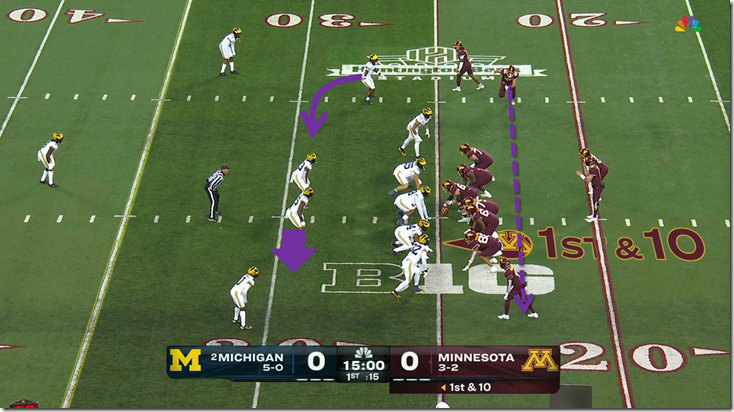

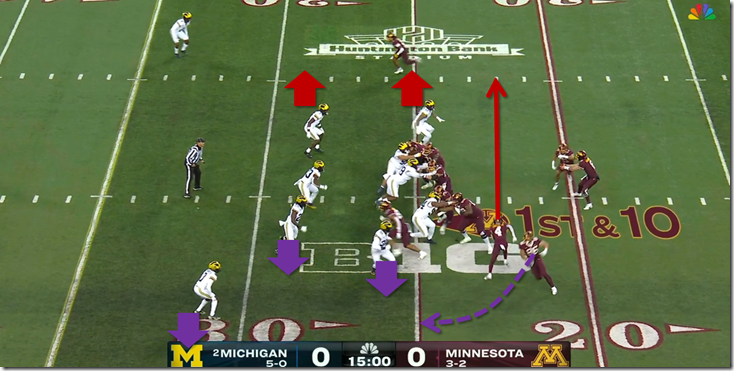
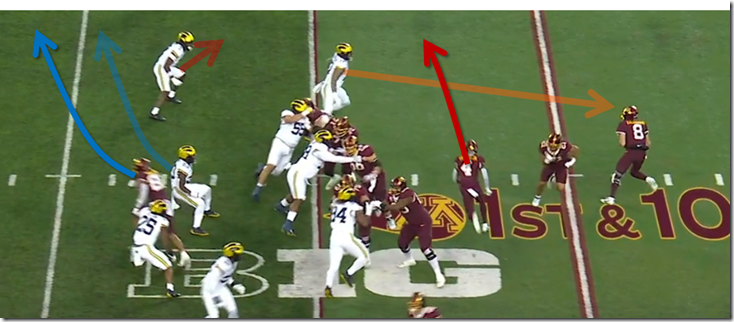
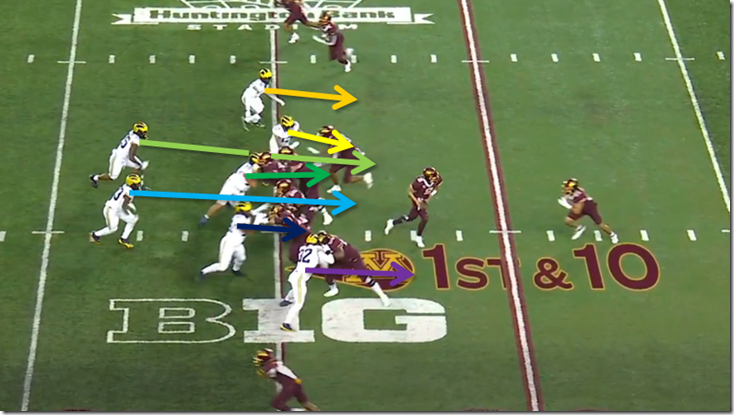
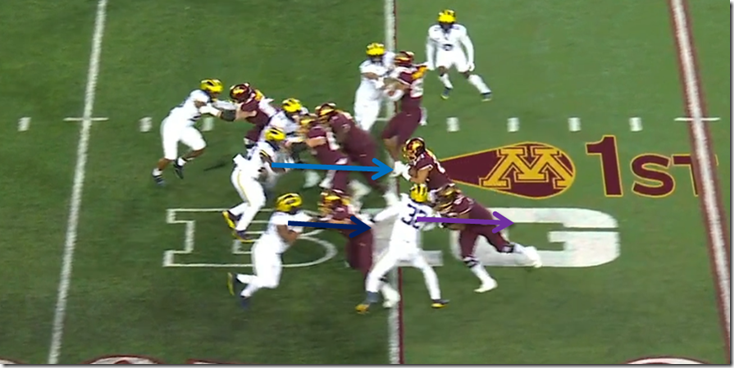
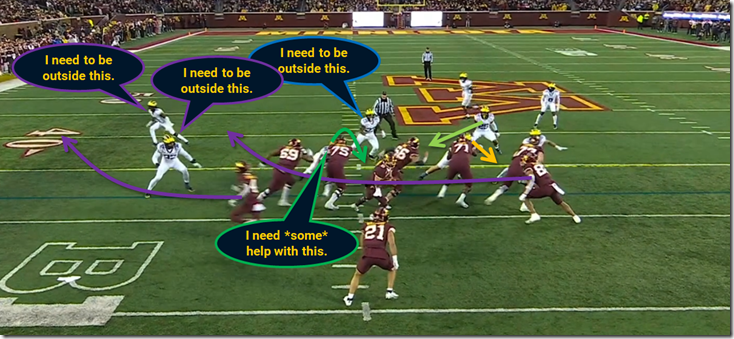
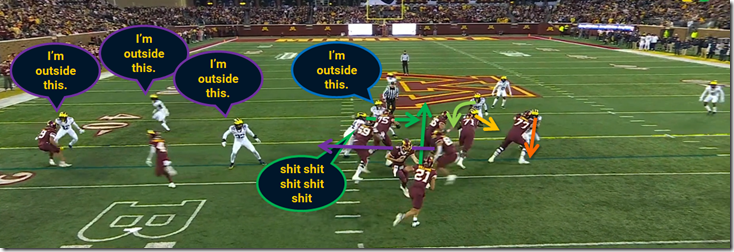
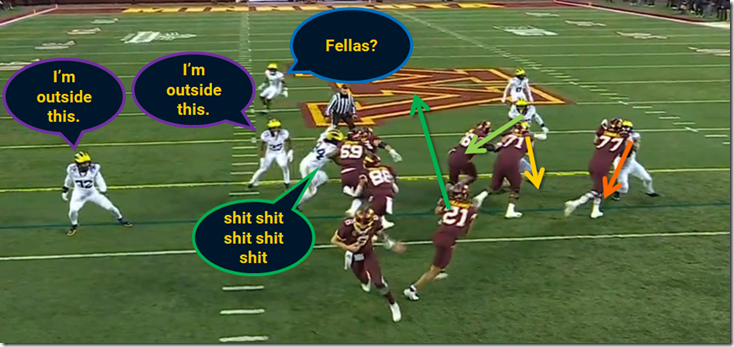

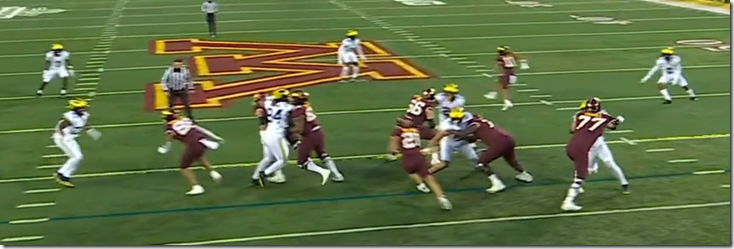
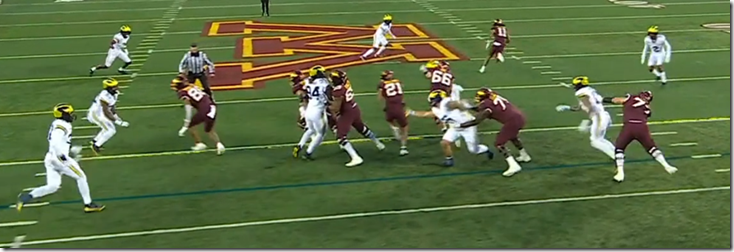
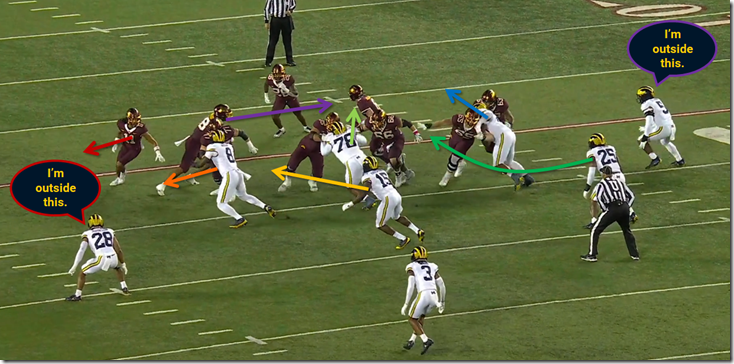
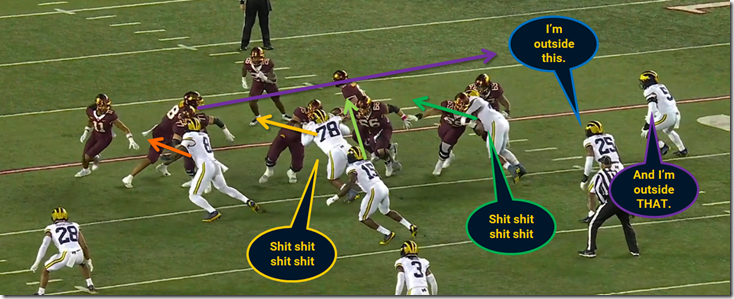
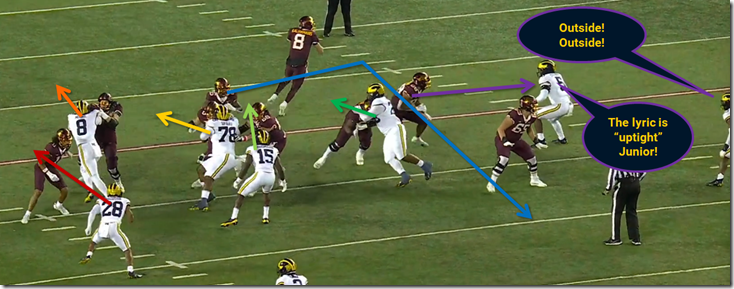
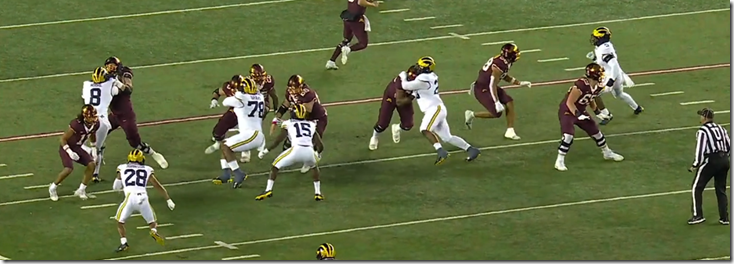
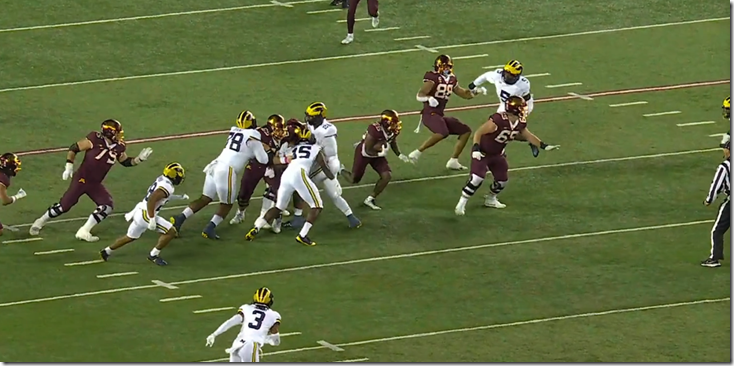
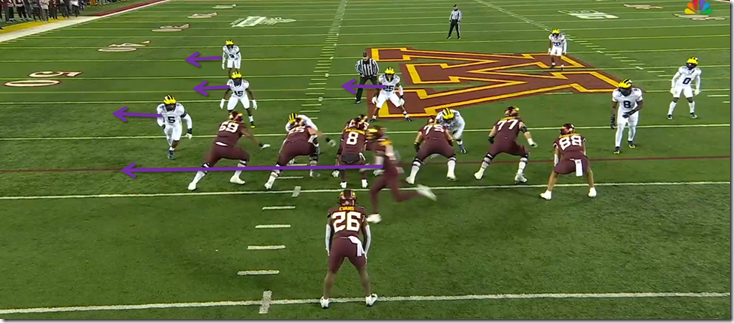
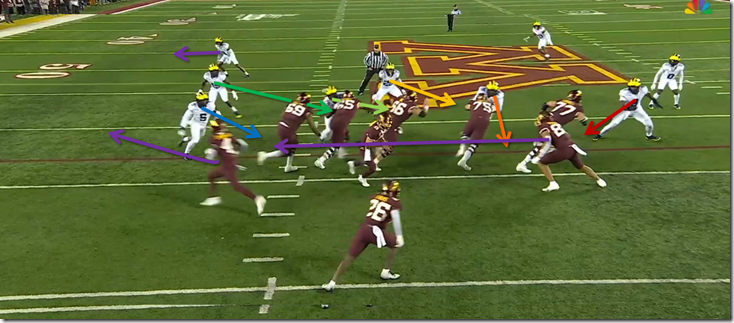
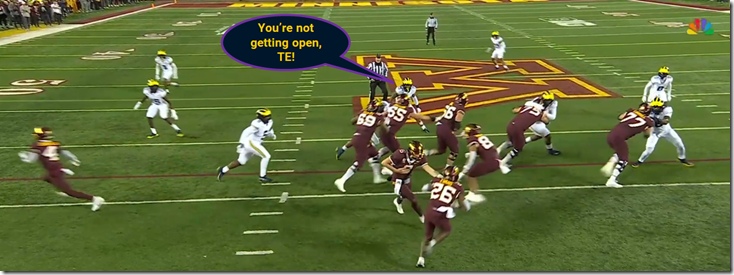

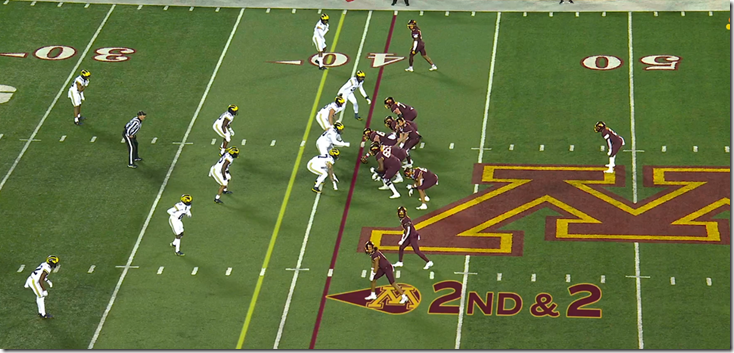
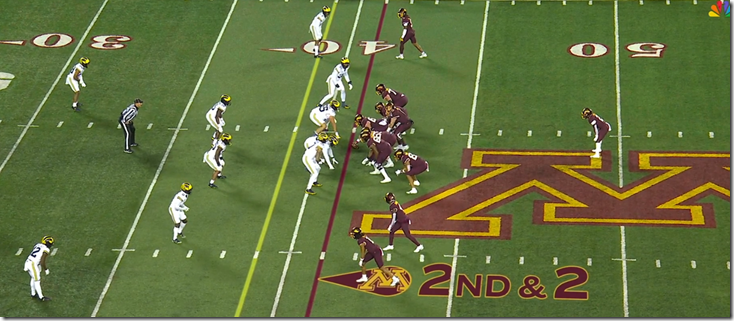
Comments